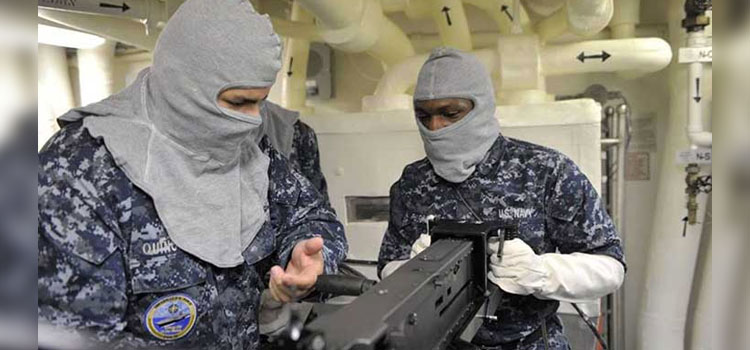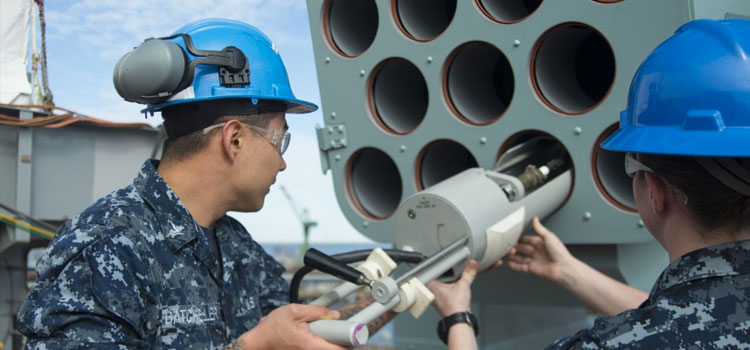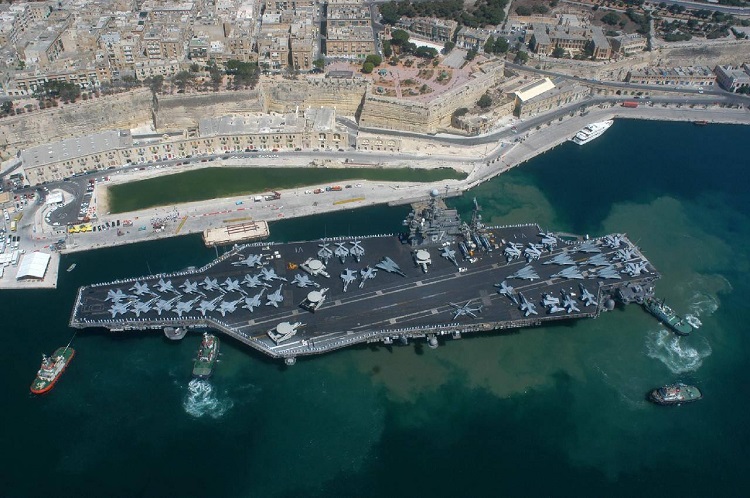The Gunners
 The MK 15 Phalanx Close-In Weapons System developed by Raytheon Systems Company satisfies the primary function of defending against anti-ship missiles using an M-61A1 Gatling gun type. It weighs around 12,500 pounds and is capable of firing 3,000 rounds per minute with a 20mm caliber. It was first deployed in the year 1980 aboard USS America. It has a Self-contained search and tracks radar with ammunitions like Armor Piercing Discarding Sabot (APDS) and Depleted Uranium or Tungsten sub-caliber penetrator. In the image, you can see a highly skilled pair of gunners handling one of the ship’s .50-caliber machine guns during a drill.
The MK 15 Phalanx Close-In Weapons System developed by Raytheon Systems Company satisfies the primary function of defending against anti-ship missiles using an M-61A1 Gatling gun type. It weighs around 12,500 pounds and is capable of firing 3,000 rounds per minute with a 20mm caliber. It was first deployed in the year 1980 aboard USS America. It has a Self-contained search and tracks radar with ammunitions like Armor Piercing Discarding Sabot (APDS) and Depleted Uranium or Tungsten sub-caliber penetrator. In the image, you can see a highly skilled pair of gunners handling one of the ship’s .50-caliber machine guns during a drill.
Rifles
 In the image, you can see an M-14, an automatic rifle made in America attached to the end in order to launch a line to the pier. It fires 7.62×51mm NATO (commercial .308 Winchester) ammunition. There is a weight made of rubber attached to the line meant to be shot at someone standing on the pier. The M-14 has a historical significance as it is the last American battle rifle to be issued in quantity to U.S. military personnel. It was developed after a continuous chain of innovations and advancement which started from the M1 rifle. Moreover, the M-14 is the basis for M-21 and M-25 rifle. Currently, a new version of M-14, the Mk 14 Enhanced Battle Rifle is being used.
In the image, you can see an M-14, an automatic rifle made in America attached to the end in order to launch a line to the pier. It fires 7.62×51mm NATO (commercial .308 Winchester) ammunition. There is a weight made of rubber attached to the line meant to be shot at someone standing on the pier. The M-14 has a historical significance as it is the last American battle rifle to be issued in quantity to U.S. military personnel. It was developed after a continuous chain of innovations and advancement which started from the M1 rifle. Moreover, the M-14 is the basis for M-21 and M-25 rifle. Currently, a new version of M-14, the Mk 14 Enhanced Battle Rifle is being used.
Missile Launcher
 The USS Gerald R. Ford boasts of being equipped with The Rolling Airframe Missile (RAM) System, which is technologically one of the most advanced ships self-defense weapons. Its major qualities are that of having a lightning quick reaction, fire-and-forget weapon and of being extremely light in weight. It is capable of engaging in multiple threats because of its passive radio frequency and infrared guidance design. In the image, a test is being performed on the USS Ford’s Rolling Airframe Missile launching system by the Fire Controlman 3rd Class Lawrence Batcheller.
The USS Gerald R. Ford boasts of being equipped with The Rolling Airframe Missile (RAM) System, which is technologically one of the most advanced ships self-defense weapons. Its major qualities are that of having a lightning quick reaction, fire-and-forget weapon and of being extremely light in weight. It is capable of engaging in multiple threats because of its passive radio frequency and infrared guidance design. In the image, a test is being performed on the USS Ford’s Rolling Airframe Missile launching system by the Fire Controlman 3rd Class Lawrence Batcheller.
Monitoring the Flight Deck
 The USS Gerald R. Ford has an increased flight deck space and an improved hull design when compared to Nimitz. The ship towers at a height of 134 feet and has an expansive hangar bay the place where the aircraft are stored when they are not in use. It has advanced weapons elevators allowing an easy way for the movement of ordnance from the magazines to the aircraft by the sailors. In the image, Beatriz Milique is monitoring the flight deck of the USS Ford from the Primary Flight Control.
The USS Gerald R. Ford has an increased flight deck space and an improved hull design when compared to Nimitz. The ship towers at a height of 134 feet and has an expansive hangar bay the place where the aircraft are stored when they are not in use. It has advanced weapons elevators allowing an easy way for the movement of ordnance from the magazines to the aircraft by the sailors. In the image, Beatriz Milique is monitoring the flight deck of the USS Ford from the Primary Flight Control.
Electromagnetic Launchers
 A type of aircraft launching system developed by General Atomics for the United States Navy, Electromagnetic Aircraft Launch System (EMALS) is capable of launching carrier-based aircraft from an aircraft catapult with the help of latest linear motor drive. It is specially developed for USS Gerald R. Ford. In the image you can see, a launcher test of the ship’s Electromagnetic Aircraft Launching System (EMALS) being conducted by 1st Class Robert McLendon. One of the significant advantages of this system is the smooth acceleration it provides to the aircraft.
A type of aircraft launching system developed by General Atomics for the United States Navy, Electromagnetic Aircraft Launch System (EMALS) is capable of launching carrier-based aircraft from an aircraft catapult with the help of latest linear motor drive. It is specially developed for USS Gerald R. Ford. In the image you can see, a launcher test of the ship’s Electromagnetic Aircraft Launching System (EMALS) being conducted by 1st Class Robert McLendon. One of the significant advantages of this system is the smooth acceleration it provides to the aircraft.
Control Area
 Just below the Primary Flight Control is the ship’s bridge, which is also very stunning. Capable of producing 9,900 tons of air conditioning, the bridge also displays an improvement in maintainability and efficiency. The system present in the bridge are fully automated and use highly advanced technology. They use touchscreen interfaces and is reliant on electrical and electronic systems. The only thing which is taken from the past models is the metal wheel connected to the transmission system.
Just below the Primary Flight Control is the ship’s bridge, which is also very stunning. Capable of producing 9,900 tons of air conditioning, the bridge also displays an improvement in maintainability and efficiency. The system present in the bridge are fully automated and use highly advanced technology. They use touchscreen interfaces and is reliant on electrical and electronic systems. The only thing which is taken from the past models is the metal wheel connected to the transmission system.
